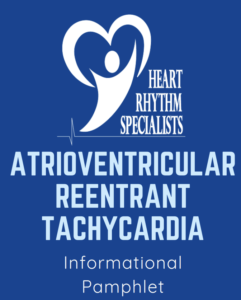What is AVRT?
Atrioventricular reentrant tachycardia (AVRT) is the second most common type of supraventricular tachycardia (SVT), or an abnormally fast heartbeat.
AVRT is caused by an extra, rogue electrical pathway (AKA an accessory pathway) between the heart’s upper and lower chambers that forms an abnormal loop of electrical activity. It occurs more often in younger women and children and is associated with Wolff-Parkinson-White syndrome.
How is AVRT Diagnosed?
Dr. Yoo will use a combination of
a physical exam, medical history,
and testing, which may include:
- electrocardiogram (ECG/EKG)
- Holter monitor
- echocardiogram
- stress test
- electrophysiological (EP) test
Risk Factors include:
- being female
- family history disorders
- thyroid problems
- certain drugs and supplements
- anxiety or emotional stress
- physical fatigue
- diabetes
- obstructive sleep apnea
- pregnancy
- chronic lung disease
Causes of AVRT include:
- certain medications, like those for asthma, colds, and allergies
- smoking, drinking too much alcohol, and consuming too much caffeine stimulants and recreational drugs
- prior cardiac surgery
Symptoms of AVRT
Symptoms of AVRT often begin to appear in teens and young
adults. Symptoms include:
- fluttering in the chest
- rapid heartbeat (palpitations)
- shortness of breath
- lightheadedness or dizziness
- sweating
- pounding sensation in the neck
- fainting (syncope) or nearfainting
Treatments for AVRT
Dr. Yoo will determine the type of treatment necessary based on the frequency of your episodes and the symptoms they cause. Treatments may include: a carotid sinus massage, cardioversion, antiarrhythmic medication(s), a catheter ablation procedure, a pacemaker implant, or Vagal maneuvers.
It is a good idea to keep a log of your heart rate, symptoms, and
activity at the time of an episode in order to know what triggers to avoid.
Additional Resources
